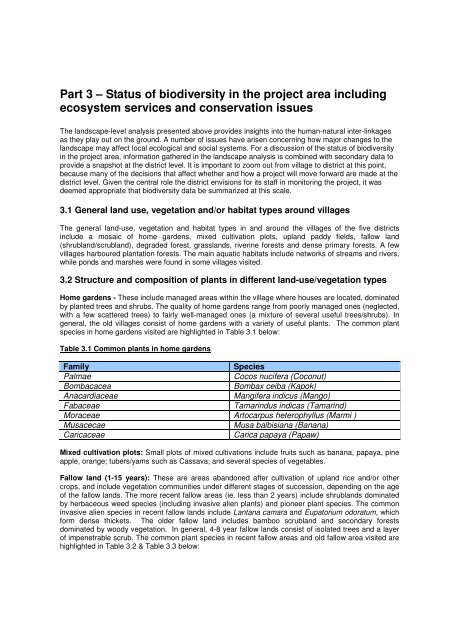Part 1 – A Rapid Participatory Biodiversity Assessment - IUCN
Part 1 – A Rapid Participatory Biodiversity Assessment - IUCN
Part 1 – A Rapid Participatory Biodiversity Assessment - IUCN
Create successful ePaper yourself
Turn your PDF publications into a flip-book with our unique Google optimized e-Paper software.
<strong>Part</strong> 3 <strong>–</strong> Status of biodiversity in the project area including<br />
ecosystem services and conservation issues<br />
The landscape-level analysis presented above provides insights into the human-natural inter-linkages<br />
as they play out on the ground. A number of issues have arisen concerning how major changes to the<br />
landscape may affect local ecological and social systems. For a discussion of the status of biodiversity<br />
in the project area, information gathered in the landscape analysis is combined with secondary data to<br />
provide a snapshot at the district level. It is important to zoom out from village to district at this point,<br />
because many of the decisions that affect whether and how a project will move forward are made at the<br />
district level. Given the central role the district envisions for its staff in monitoring the project, it was<br />
deemed appropriate that biodiversity data be summarized at this scale.<br />
3.1 General land use, vegetation and/or habitat types around villages<br />
The general land-use, vegetation and habitat types in and around the villages of the five districts<br />
include a mosaic of home gardens, mixed cultivation plots, upland paddy fields, fallow land<br />
(shrubland/scrubland), degraded forest, grasslands, riverine forests and dense primary forests. A few<br />
villages harboured plantation forests. The main aquatic habitats include networks of streams and rivers,<br />
while ponds and marshes were found in some villages visited.<br />
3.2 Structure and composition of plants in different land-use/vegetation types<br />
Home gardens - These include managed areas within the village where houses are located, dominated<br />
by planted trees and shrubs. The quality of home gardens range from poorly managed ones (neglected,<br />
with a few scattered trees) to fairly well-managed ones (a mixture of several useful trees/shrubs). In<br />
general, the old villages consist of home gardens with a variety of useful plants. The common plant<br />
species in home gardens visited are highlighted in Table 3.1 below:<br />
Table 3.1 Common plants in home gardens<br />
Family Species<br />
Palmae Cocos nucifera (Coconut)<br />
Bombacacea Bombax ceiba (Kapok)<br />
Anacardiaceae Mangifera indicus (Mango)<br />
Fabaceae Tamarindus indicas (Tamarind)<br />
Moraceae Artocarpus heterophyllus (Marmi )<br />
Musacecae Musa balbisiana (Banana)<br />
Caricaceae Carica papaya (Papaw)<br />
Mixed cultivation plots: Small plots of mixed cultivations include fruits such as banana, papaya, pine<br />
apple, orange; tubers/yams such as Cassava; and several species of vegetables.<br />
Fallow land (1-15 years): These are areas abandoned after cultivation of upland rice and/or other<br />
crops, and include vegetation communities under different stages of succession, depending on the age<br />
of the fallow lands. The more recent fallow areas (ie. less than 2 years) include shrublands dominated<br />
by herbaceous weed species (including invasive alien plants) and pioneer plant species. The common<br />
invasive alien species in recent fallow lands include Lantana camara and Eupatorium odoratum, which<br />
form dense thickets. The older fallow land includes bamboo scrubland and secondary forests<br />
dominated by woody vegetation. In general, 4-8 year fallow lands consist of isolated trees and a layer<br />
of impenetrable scrub. The common plant species in recent fallow areas and old fallow area visited are<br />
highlighted in Table 3.2 & Table 3.3 below:

















